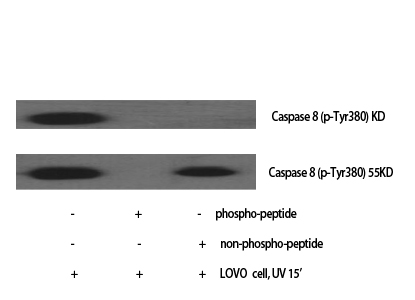Cleaved-Caspase-8 (D384) Cell-Based Colorimetric ELISA Kit
- 货号:KA3940C
- 应用:ELISA
- 种属:Human
- 基因名称:
- CASP8
- 蛋白名称:
- Caspase8
- Human Gene Id:
- 841
- Human Swiss Prot No:
- Q14790
- Mouse Swiss Prot No:
- O89110
- 储存:
- 2-8°C/6 months
- 其他名称:
- Caspase-8 (CASP-8) (EC 3.4.22.61) (Apoptotic cysteine protease) (Apoptotic protease Mch-5) (CAP4) (FADD-homologous ICE/ced-3-like protease) (FADD-like ICE) (FLICE) (ICE-like apoptotic protease 5) (MORT1-associated ced-3 homolog) (MACH) [Cleaved into: Caspase-8 subunit p18;Caspase-8 subunit p10]
- 检测方法:
- Colorimetric
- 背景:
- catalytic activity:Strict requirement for Asp at position P1 and has a preferred cleavage sequence of (Leu/Asp/Val)-Glu-Thr-Asp-|-(Gly/Ser/Ala).,disease:Defects in CASP8 are the cause of caspase-8 deficiency (CASP8D) [MIM:607271]. CASP8D is a disorder resembling autoimmune lymphoproliferative syndrome (ALPS). It is characterized by lymphadenopathy, splenomegaly, and defective CD95-induced apoptosis of peripheral blood lymphocytes (PBLs). It leads to defects in activation of T-lymphocytes, B-lymphocytes, and natural killer cells leading to immunodeficiency characterized by recurrent sinopulmonary and herpes simplex virus infections and poor responses to immunization.,domain:Isoform 9 contains a N-terminal extension that is required for interaction with the BCAP31 complex.,function:Most upstream protease of the activation cascade of caspases responsible for the TNFRSF6/FAS mediated and TNFRSF1A induced cell death. Binding to the adapter molecule FADD recruits it to either receptor. The resulting aggregate called death-inducing signaling complex (DISC) performs CASP8 proteolytic activation. The active dimeric enzyme is then liberated from the DISC and free to activate downstream apoptotic proteases. Proteolytic fragments of the N-terminal propeptide (termed CAP3, CAP5 and CAP6) are likely retained in the DISC. Cleaves and activates CASP3, CASP4, CASP6, CASP7, CASP9 and CASP10. May participate in the GZMB apoptotic pathways. Cleaves ADPRT. Hydrolyzes the small-molecule substrate, Ac-Asp-Glu-Val-Asp-|-AMC. Likely target for the cowpox virus CRMA death inhibitory protein. Isoforms 5, 6, 7 and 8 lack the catalytic site and may interfere with the pro-apoptotic activity of the complex.,online information:CASP8 mutation db,polymorphism:Genetic vaiations in CASP8 are associated with reduced risk of lung cancer [MIM:211980] in a population of Han Chinese subjects. Genetic vaiations are also associated with decreased risk of cancer of various other forms including esophageal, gastric, colorectal, cervical, and breast, acting in an allele dose-dependent manner.,PTM:Generation of the subunits requires association with the death-inducing signaling complex (DISC), whereas additional processing is likely due to the autocatalytic activity of the activated protease. GZMB and CASP10 can be involved in these processing events.,PTM:Phosphorylated upon DNA damage, probably by ATM or ATR.,similarity:Belongs to the peptidase C14A family.,similarity:Contains 2 DED (death effector) domains.,subunit:Heterotetramer that consists of two anti-parallel arranged heterodimers, each one formed by a 18 kDa (p18) and a 10 kDa (p10) subunit. Interacts with FADD, CFLAR and PEA15. Isoform 9 interacts at the endoplasmic reticulum with a complex containing BCAP31, BAP29, BCL2 and/or BCL2L1. Interacts with TNFAIP8L2.,tissue specificity:Isoforms 1, 5 and 7 are expressed in a wide variety of tissues. Highest expression in peripheral blood leukocytes, spleen, thymus, and liver. Barely detectable in brain, testis, and skeletal muscle.,
- 功能:
- angiogenesis, blood vessel development, embryonic epithelial tube formation, neural tube formation, vasculature development, morphogenesis of an epithelium, immune system development, leukocyte differentiation, myeloid leukocyte differentiation, protein complex assembly, proteolysis, apoptosis, induction of apoptosis, heart development, cell death, induction of apoptosis by extracellular signals, activation of pro-apoptotic gene products,macromolecule catabolic process, embryonic development ending in birth or egg hatching, positive regulation of signal transduction, response to organic substance, regulation of protein kinase cascade, positive regulation of cell communication, positive regulation of protein kinase cascade, regulation of cell death, positive regulation of cell death,programmed cell death, induction of programmed cell death, death, morphogenesis of embryonic epithelium, ne
- 细胞定位:
- Cytoplasm . Nucleus .
- 组织表达:
- Isoform 1, isoform 5 and isoform 7 are expressed in a wide variety of tissues. Highest expression in peripheral blood leukocytes, spleen, thymus and liver. Barely detectable in brain, testis and skeletal muscle.
- June 19-2018
- WESTERN IMMUNOBLOTTING PROTOCOL
- June 19-2018
- IMMUNOHISTOCHEMISTRY-PARAFFIN PROTOCOL
- June 19-2018
- IMMUNOFLUORESCENCE PROTOCOL
- September 08-2020
- FLOW-CYTOMEYRT-PROTOCOL
- May 20-2022
- Cell-Based ELISA│解您多样本WB检测之困扰
- July 13-2018
- CELL-BASED-ELISA-PROTOCOL-FOR-ACETYL-PROTEIN
- July 13-2018
- CELL-BASED-ELISA-PROTOCOL-FOR-PHOSPHO-PROTEIN
- July 13-2018
- Antibody-FAQs


